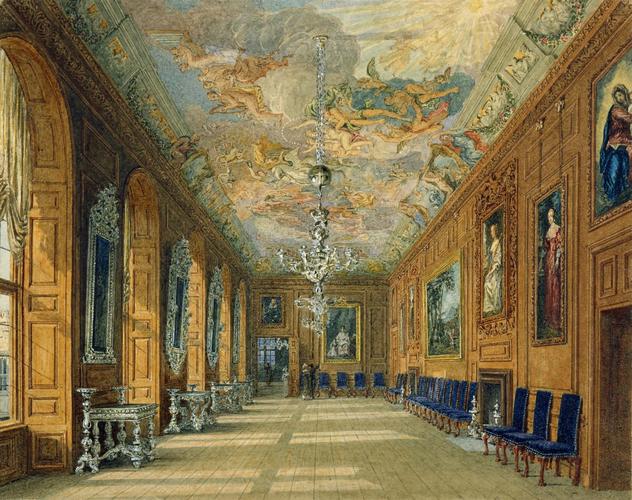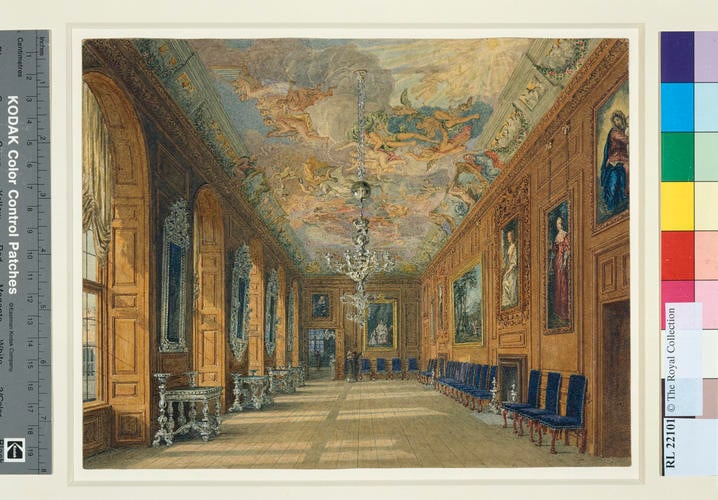Windsor Castle: The Queen’s Ballroom c. 1817
Pencil, watercolour with touches of bodycolour | 19.8 x 25.2 cm (sheet of paper) | RCIN 922101

Charles Wild (1781-1835)
Windsor Castle: The Queen’s Ballroom c. 1817

Charles Wild (1781-1835)
Windsor Castle: The Queen’s Ballroom c. 1817

Charles Wild (1781-1835)
Windsor Castle: The Queen’s Ballroom c. 1817



-
A watercolour view of the interior of the Queen's Ballroom, Windsor Castle, prepared for one of the plates in William Henry Pyne's 'History of the Royal Residences' (1816-1819). Engraved by Sutherland, the print published 1.2.1817.
This watercolour records a number of paintings hanging in the Queen's Ballroom, with a particular concentration of Van Dycks. From the publication of this watercolour in the second decade of the nineteenth century, this room has been associated with portraiture and most prominently the works of the Flemish artist. The first recording of a complete Van Dyck hang dates from 1837, and by the end of the 1830s the ballroom was known as the Van Dyck Room, a title that endured into the twentieth century.
The Queen's Ballroom was west-facing, looking onto Engine Court and leading (to its north) into the Drawing Room. At this date the late seventeenth-century panelling, carving and ceiling (painted by Verrio with Charles II [in the guise of Perseus] giving freedom to Europe [in the guise of Andromeda]) survived relatively unaltered. The room was the largest in the Queen's Apartments and served the combined function of gallery and ballroom. Elements of two of the four sets of silver furniture shown here survive in the Royal Collection . The other two sets - the central ones in this view - were acquired in 1732 for George II's palace at Herrenhausen, near Hanover. With the three silver chandeliers in this room, and the two in the Queen's Drawing Room, they were housed at Windsor during the Napoleonic upheavals but were returned to Hanover shortly afterwards.
The paintings include (on the far wall) Ramsay's portrait of Queen Charlotte and her two eldest sons of 1764 (RCIN 404922), and facing it (out of view) Copley's painting of three of the princesses of 1785 (401405), both transferred to Windsor from Kensington in 1805. The others can be identified from the 1816 inventory of Windsor Castle: on the centre of the wall opposite the windows hangs Zuccarelli’s Isaac and Rebecca (401454), which oddly also appears in Wild’s illustration of the Queen’s Audience Chamber next door (922100); this is flanked by two overmantles with full-length Van Dyck portraits of Beatrice de Cusance (404404, left) and Duchess of Richmond (404402, right); these in turn are flanked by Van Dyck’s Countess of Dorset (404121, barely visible at the far end) and Woman washing her hands (404399, near to us). The overdoor facing us is Van Somer’s Earl of Pembroke (405870); the one to the right at the far end of the space (barely invisible) is Correggio’s John the Baptist (406179); the one at the right margin is Tintoretto's Virgin (402751).
In the 1830s the Queen's Ballroom was altered to its present appearance by Wyatville for William IV. At that time most of the seventeenth-century decoration was removed and the marble chimneypiece recorded by Pyne in the Queen's Bedchamber was transferred to the centre of the east wall of the Ballroom, to replace the two chimneypieces shown here.
Pyne's 'History of the Royal Residences' was a three-volume publication which encompassed a number of royal residences, including Windsor Castle (vol. 1) and Buckingham House (vol. 2), presenting 100 hand-coloured engravings of exteriors and interiors accompanied by descriptive texts. The 100 watercolours which were engraved for the publication survive in the Royal Library; these watercolours are exactly the size of the image on the printed plates, and may perhaps have been intended as colour guides for the artists responsible for hand-painting the monochrome prints.Provenance
Probably acquired by George IV
-
Creator(s)
Acquirer(s)
-
Medium and techniques
Pencil, watercolour with touches of bodycolour
Measurements
19.8 x 25.2 cm (sheet of paper)
Other number(s)
RL 22101Alternative title(s)
The Queen's Ballroom or Van Dyck Room, also called the Queen's Gallery, at Windsor Castle.







